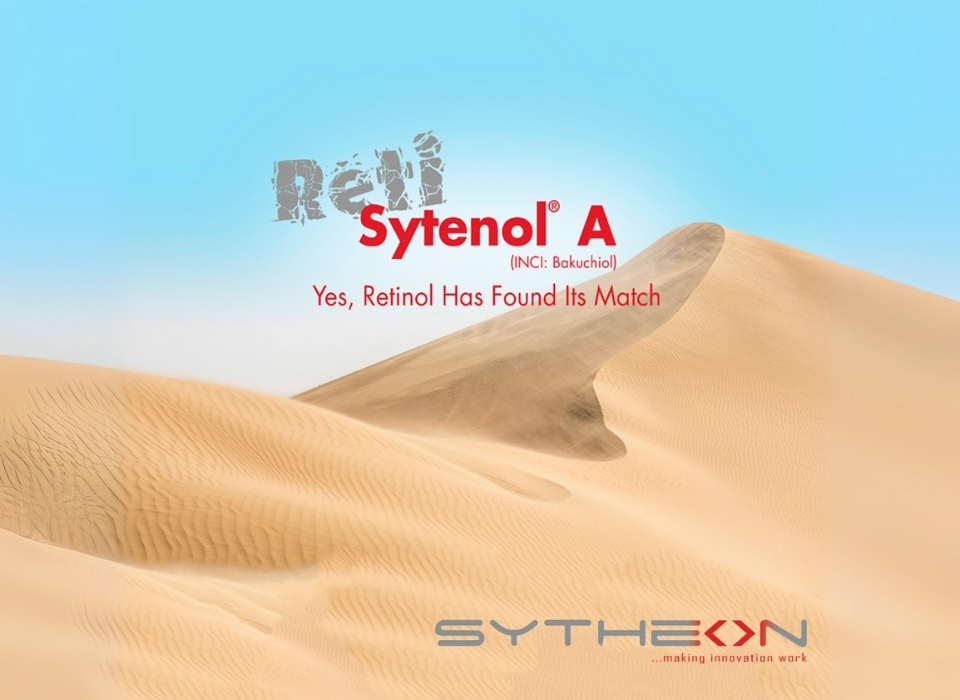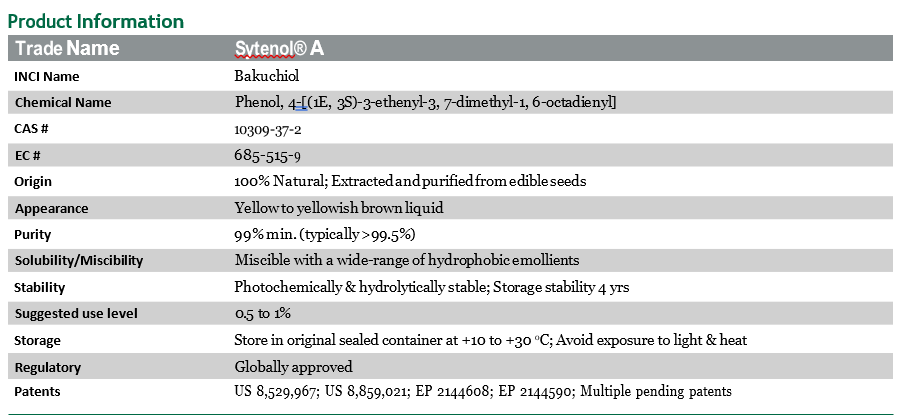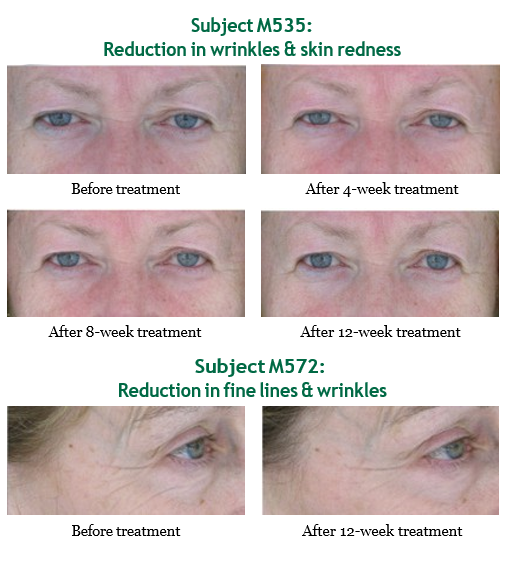
Sytenol® A
As we age skin loses its elasticity and becomes thin, weak and prone to wrinkles and hyperpigmentation. How can this be prevented? The main goal of anti-aging products is to decrease and eventually eliminate the appearance of fine lines and wrinkles and provide even-toning effects. The way to achieve this goal is to keep wrinkles from forming in the first place. This means preventing skin from further damage, restoring mainly the extra cellular matrix (ECM), dermal-epidermal junction (DEJ) areas and preserving skin hydration.

From the perspective of topically applied compositions, a small molecule without having the negatives of Retinol that safely mimics the properties of Retinol (Fisher et al., FASEB J,1002-1013, 1996) is a greatly sought after ingredient. Volcanic plots illustrate the molecular signatures of Retinol and Sytenol® A of a DNA microarray experiment using reconstructed full thickness epidermis. This shows a very similar overall shape, indicating similar overall modulation of gene expressions in the skin substitute model. Multiple comparative studies revealed Sytenol® A to be the true alternative to Retinol (Chaudhuri, In Cosmeceuticals and Active Cosmetics, 3r Edition, Eds., Maibach et al., Chapter 1, 1-18, 2015) for anti-aging applications and does not have the inherent safety & stability issues of Retinol. A recent randomized, double-blind clinical study between Sytenol® A and Retinol carried out by UC-Davis Dermatologists demonstrated that both compounds significantly decreased wrinkle surface area and hyperpigmentation, with no statistical difference between the compounds. The Retinol users reported more facial skin scaling, burning and stinging. Authors concluded that Sytenol® A is a more tolerable alternative to Retinol (Dhaliwal et al, British J Dermatology, 180:289-296, 2019.
Volcanic plots of DNA microarray data: Retinol vs. Sytenol®A

• Human volunteers – 17; 16 Completed; Age – 41 to 60 yrs; Caucasian (14),
Hispanics (2)
• Study duration – 12 weeks
• Test sites – Full face
• Test substance – Lotion with 0.5% Sytenol® A; Contains No sunscreen and No moisturizer
• Application frequency – About 2 g twice a day
• Methodology – Expert grading/Self-assessment by panelists (Grading 0 to 4): (1) Roughness & Dryness; (2) Fine lines & wrinkles; (3) Skin tone; (4) Skin elasticity & firmness; (5) Radiance; (6) Brightening; (7) Overall eye-area appearance; Silicone Replica Analysis: Wrinkle depth & Skin roughness; Photography: Before & after the treatments; Readings were taken at baseline, 4, 8 & 12 weeks.
• Statistical Analysis – Statistical significance defined as p ≤0.05
The results clearly showed that, after twelve weeks treatment, significant improvement in lines and wrinkles, pigmentation, elasticity, firmness and overall photo-damage was observed, with no irritating effect on skin. Based on these results and the comparative studies of Retinol and Sytenol® A done by Sytheon, we conclude that Sytenol® A is the first true Retinol-like anti-aging product (Chaudhuri & Bojanowski, Intern J Cosmet Sci, 36(3):221-230, 2014).

In aged skin, collapsed fibroblasts produce low levels of collagen and high levels of collagen-degrading enzymes. This imbalance advances the aging process in a self-perpetuating, never-ending deleterious cycle. Treatments such as topical retinol or retinoic acid have been clinically proven to stimulate production of new, undamaged collagen (Fisher et al., Arch Dermatol, 144(5):666-672, 2008). The attachment of fibroblasts to this new collagen allows elasticity, which in turn balances collagen production and degradation, thereby slowing, if not reversing, the aging process. We have measured collagen stimulation by ELISA and histochemistry methods. The ELISA assessment employed cell-culture conditioned media from neonatal (type I & IV collagens) or mature (type III collagen) fibroblasts (Chaudhuri & Bojanowski, Intern J Cosmet Sci, 36(3):221-230, 2014). Results of this findings, as summarized in the Table (% stimulation vs control) below, demonstrated a significant improvement in collagen stimulation by Sytenol® A as compared to Retinol, hence greater restorative effect is expected.
|
Test material (10 µg/ml) |
Collagen I |
Collagen III |
Collagen IV |
|
Sytenol® A |
147 |
150 |
119 |
|
Retinol |
119 |
148 |
100 |
Skin aging and inflammation are critically linked. The inflammation-induced aging process involves a highly complex chain of events, by which acute inflammation gradually gives way to chronic or silent inflammation. It is this underlying inflammation that ultimately exhausts the body’s defense system resulting in collagen and elastin degradation and the breakdown of the skin’s barrier function (Woods et al., Aging Dis, 3(1):130-140, 2012). The inflammatory cascade of reactions that erode the skin’s structure – ultimately deep wrinkles, hyperpigmentation and non-elastic tissues. Sytenol® A controls inflammation by inhibiting/down-regulating pro-inflammatory genes and enzymes (Chaudhuri, In Cosmecuticals and Active Cosmetics, 3rd edition, Eds. Maibach et al., Chapter 1, 1-8, 2015).
DNA microarray test using full thickness Epiderm tissue (Mattek)
• Retinol and Sytenol® A were dissolved in DMSO, further diluted in water and applied to full thickness Epiderm tissues
• Incubation for 48 hours
• Selected gene expressions having >± 2-fold change
• Statistical significance: p = ≤0.05

Sytenol® A is a lipophilic compound miscible in a wide variety of emollients, such as, caprylic/capric triglycerides, Hydra Synol® DOI (Isosorbide dilinoleate), ethyl linoleate, C12-15 alkyl benzoates, squalane, jojoba oils, olive oils, etc. Sytenol® A is dark yellow/brown in color, but will not affect the color of finished formula.
• Sytenol® A can be easily formulated into:
– Creams – Lotions
– Oils – Serums
– Hydro-alcoholic sprays – Color cosmetics
• Sytenol® A should be used at a level of 0.5 to 1.0% (w/w) of finished formulation
• Sytenol® A can be added directly to the oil phase.
• Sytenol® A is not miscible with silicones, but both products can be added together into an oil phase.
• Avoid prolonged heating above 75ºC.
• Addition of a small amount of a chelating agent (0.1%) is helpful in overcoming coloration issue due to the presence of iron or copper ions
• The finished product must be acidic, preferably having pH below 6 and must be protected from prolong exposure to heat and light for maintaining product integrity over time.
• Sytenol® A can be formulated into serums using PEG-40 HCO, Polysorbate 20 and other surfactants
Author: Gülden Değirmenci
Technical Sales Manager - Personal Care / Orbiter Solutions